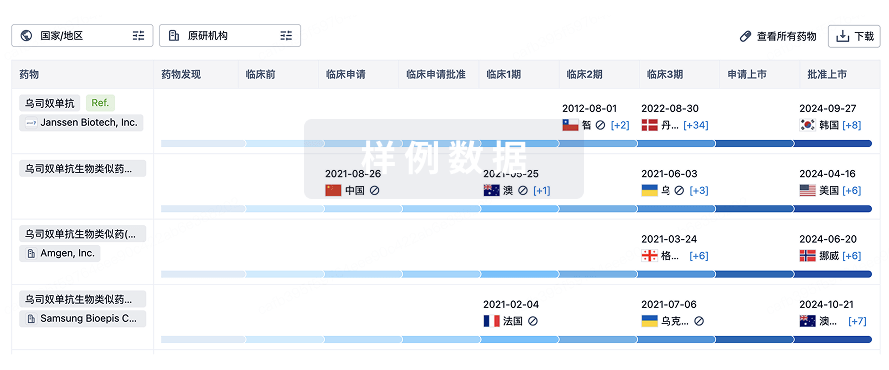预约演示
更新于:2025-10-25
Recombinant human growth hormone(Shanghai United Cell Biotechnology)
重组人生长激素 (上海联合赛尔)
更新于:2025-10-25
概要
基本信息
原研机构 |
在研机构 |
非在研机构- |
权益机构- |
最高研发阶段批准上市 |
首次获批日期 中国 (1999-01-01), |
最高研发阶段(中国)批准上市 |
特殊审评- |
登录后查看时间轴
结构/序列
Sequence Code 26401985

当前序列信息引自: *****
关联
2
项与 重组人生长激素 (上海联合赛尔) 相关的临床试验CTR20210879
评估受试制剂人生长激素注射液(1.5ml:5mg)与参比制剂注射用人生长激素(珍怡,1.33mg/4IU/1.0ml)在健康成年男性受试者中的随机、开放、单中心、单剂量、两周期、两交叉生物等效性试验
研究单次皮下注射受试制剂人生长激素注射液(规格:1.5ml:5mg,上海联合赛尔生物工程有限公司生产)与参比制剂注射用人生长激素(珍怡,规格:1.33mg/4IU/1.0ml;上海联合赛尔生物工程有限公司生产)在健康成年男性受试者体内的药代动力学,评价皮下注射两种制剂的生物等效性。
开始日期2021-06-21 |
申办/合作机构 |
CTR20130246
注射用重组人生长激素治疗生长激素缺乏所致生长缓慢的随机、单盲、多中心、阳性药平行对照的临床研究
评价注射用重组人生长激素治疗生长激素缺乏所致生长缓慢的疗效及安全性
开始日期2013-02-19 |
申办/合作机构 |
100 项与 重组人生长激素 (上海联合赛尔) 相关的临床结果
登录后查看更多信息
100 项与 重组人生长激素 (上海联合赛尔) 相关的转化医学
登录后查看更多信息
100 项与 重组人生长激素 (上海联合赛尔) 相关的专利(医药)
登录后查看更多信息
93
项与 重组人生长激素 (上海联合赛尔) 相关的文献(医药)2025-01-01·Journal of Analytical Methods in Chemistry
Development of Competitive ELISAs Suitable for Detection of Recombinant Human Growth Hormone in Illegal Nutritional Supplements
Article
作者: Procházková, B ; Karamonová, L ; Fukal, L ; Sýkora, D ; Nemeškalová, A ; Kuchař, M ; Volný, M ; Holubová, B
The use of human growth hormone (hGH) by athletes remains widespread despite being banned by the World Anti‐Doping Agency (WADA). Current commercial ELISA kits for the determination of hGH are predominantly based on the sandwich format of this method, which allows the analysis of the whole hGH molecules, but not their fragments. The abuse of these fragments by athletes is the current trend in doping. Therefore, a competitive ELISA format is needed; however, only a limited number of kits on the market are based on this principle. Furthermore, these kits are designed to detect and quantify hGH only in blood plasma, serum or tissue cultures. When analysing a nutritional supplement containing hGH using one of these ELISA kits, a false negative result was observed. In the present work, two competitive ELISA methods for the detection of hGH in illegal nutritional supplements were developed. The development of the methods involved the selection of suitable immunoreagents and their combinations with subsequent optimisation of the conditions for their use. The methods were then characterised (with LOD 0.4 and 18.4 ng/mL, according to the primary antibody) and applied to analyse real nutritional supplements. In all 34 samples suspected of containing hGH, the hormone was detected using both ELISA methods and subsequently confirmed by LC‐UV and LC‐MS. Therefore, the newly developed ELISA methods could become a valuable tool for the police in identifying illegal preparations.
2023-07-19·Disease markers
Retracted: Effect of Vitamin D Combined with Recombinant Human Growth Hormone in Children with Growth Hormone Deficiency
作者: Markers, Disease
[This retracts the article DOI: 10.1155/2022/7461958.].
2023-05-18·Studies in health technology and informatics
Participatory Study to Explore Healthcare Professionals' Perceptions of a Connected Digital Solution for Adherence Monitoring of Recombinant Human Growth Hormone Treatment: Study Protocol and First Findings.
Article
作者: Felicia Faienza, Maria ; Koledova, Ekaterina ; Vergani, Edoardo ; Rivera-Romero, Octavio ; Zucchiatti, Chantal
Adherence to recombinant human growth hormone (r-hGH; somatropin, [Saizen®], Merck Healthcare KGaA, Darmstadt, Germany) treatment is fundamental to achieve positive growth outcomes in children with growth disorders and to improve quality of life and cardiometabolic risk in adult patients affected by GH deficiency. Pen injector devices are commonly used to deliver r-hGH but, to the authors' knowledge, none is currently digitally connected. Since digital health solutions are rapidly becoming valuable tools to support patients to adhere to treatment, the combination of a pen injector connected to a digital ecosystem to monitor treatment adherence is an important advance. Here, we present the methodology and first results of a participatory workshop that assessed clinicians' perceptions on such a digital solution - the aluetta™ smartdot™ (Merck Healthcare KGaA, Darmstadt, Germany) - combining the aluetta™ pen injector and a connected device, components of a comprehensive digital health ecosystem to support pediatric patients receiving r-hGH treatment. The aim being to highlight the importance of collecting clinically meaningful and accurate real-world adherence data to support data-driven healthcare.
9
项与 重组人生长激素 (上海联合赛尔) 相关的新闻(医药)2025-05-15
·米内网
精彩内容近日,广东发布《罕见病超药品说明书用药专家共识(儿科•2025年版)》,共纳入57个品种(按通用名统计,下同),涉及73条用药信息,覆盖21种儿科罕见病。其中,6个品种2024在中国公立医疗机构终端销售额均超20亿元,不乏贝伐珠单抗等百亿级别明星药,齐鲁、康弘......优势十足;5个品种超说明书适应症达3项及以上,抗肿瘤及免疫抑制剂为主力,复星、正大天晴、上药等大放异彩。57个品种新用法曝光!470亿市场热浪不断随着罕见病诊疗技术快速发展,以及药品说明书更新相对滞后,药品在临床应用中存在一定超说明书使用的情况。特别是儿童罕见病方面,因其低发病率、药企研发动力不足;伦理限制儿童临床试验,依赖成人数据外推;发病机制和儿童生长发育情况特殊,药品研发周期长,审批滞后于临床需求;罕见病高致残/致死率的紧迫性等,迫使医患双方选择有潜在治疗获益的药品。对此,为进一步规范儿童人群罕见病超药品说明书用药的管理,促进合理用药,4月28日,广东省药学会发布了《罕见病超药品说明书用药专家共识(儿科•2025年版)》(下文简称《共识》),涵盖21种罕见病、57种治疗药物(文末附品种名单)。来源:广东省药学会官网在中国城市公立医院、县级公立医院、城市社区中心及乡镇卫生院(简称中国公立医疗机构)终端,57个纳入《共识》的品种2024年合计销售规模超过470亿元;从剂型上看,注射剂及片剂占据主导;治疗大类方面,抗肿瘤和免疫调节剂以27个品种在数量上领跑,心脑血管系统药物(7个)、全身用激素类制剂(不含性激素和胰岛素)(6个)和消化系统及代谢药(5个)等八个品类位居其后。57个超说明用药的品种覆盖21种罕见病,其中13种收录于我国第一批罕见病目录,包括Alport综合征、自身免疫性脑炎、肝豆状核变性、新生儿糖尿病等;8种收录于我国第二批罕见病目录,包括ANCA相关性血管炎、先天性胆道闭锁、早产儿视网膜病等。6个超20亿重磅在列,齐鲁、康弘......优势十足纳入《共识》的57个超说明书用药品种中,不乏多款2024年在中国公立医疗机构终端销售额均超10亿元的大品种,其中6款销售额在20亿元以上,分别是贝伐珠单抗、利妥昔单抗、吗替麦考酚酯、他克莫司、重组人生长激素及康柏西普。贝伐珠单抗注射液最早由罗氏研发,于2004年首获FDA批准在美国上市,是全球首个用于抗肿瘤血管生成的单抗药物;随后于2010年获批进入中国,用于一线治疗非小细胞肺癌,以及结直肠癌、胶质母细胞瘤等癌种的治疗。得益于医保助力及其产品优势,贝伐珠单抗注射液近年来在中国公立医疗机构终端的销售额逐年攀升,2024年首度突破100亿元大关;齐鲁制药、信达生物分别以约43%和约20%的市场份额反超原研厂商罗氏(约19%)。2024年中国公立医疗机构终端贝伐珠单抗企业格局来源:米内网中国公立医疗机构药品终端竞争格局康柏西普眼用注射液为康弘药业的独家1类创新药,目前在国内已获批4项适应症:①新生血管性(湿性)年龄相关性黄斑变性;②继发于病理性近视的脉络膜新生血管引起的视力损伤;③继发于糖尿病黄斑水肿引起的视力损伤;④继发于视网膜静脉阻塞或视网膜中央静脉阻塞的黄斑水肿引起的视力损伤。作为国家基药、医保乙类药品种,康柏西普眼用注射液近两年在中国公立医疗机构终端销售额均保持两位数的同比增速,2024年拿下创新高的超22亿元,为眼科用药(化+生)TOP1产品。值得一提的是,在康柏西普等核心产品销售持续增长,以及中药业务稳健发展的助推下,康弘药业2024年及2025年一季度业绩均实现双增,营收分别达44.53亿元(+12.51%)和11.99亿元(+9.7%),净利润分别达11.91亿元(+14.02%)和4亿元(+7.09%)。近年来中国公立医疗机构终端康柏西普眼用注射液销售趋势(单位:万元)来源:米内网中国公立医疗机构药品终端竞争格局此次,贝伐珠单抗、康柏西普等品种均可超说明书用于早产儿视网膜病,这对广大早产患儿而言显然是一大福音。重组人生长激素可用于因内源性生长激素缺乏所引起的儿童生长缓慢。米内网数据显示,目前该品种有2款制剂获批上市——注射用重组人生长激素、人生长激素注射液,其分别有6家和4家企业拥有生产批文,涉及长春高新、安科生物、上海联合赛尔生物等。在中国公立医疗机构终端,重组人生长激素近年来销售额均在50亿元以上,2024年收获约54亿元,是全身用激素类制剂(不含性激素和胰岛素)通用名TOP1品种;从市场格局上看,长春高新市占比近九成,高居首位。《共识》中显示,重组人生长激素注射剂可超说明书用于罕见病Silver-Russell综合征,该疾病是一种遗传性生长障碍,主要表现为宫内发育迟缓、出生后生长落后、面部特征异常(如三角形脸、小下颌)及身体不对称等。2024年中国公立医疗机构终端全身用激素类制剂(不含性激素和胰岛素)通用名TOP5来源:米内网中国公立医疗机构药品终端竞争格局适应症TOP3品种出炉!复星、上药......大放异彩在《共识》中,有10个品种超药品说明书适应症数量在2项及以上,其中甲氨蝶呤有4项,利妥昔单抗、环磷酰胺、吗替麦考酚酯和硫唑嘌呤均有3项,托珠单抗、西地那非、泼尼松龙、阿达木单抗和英夫利西单抗则各有2项;治疗大类上,抗肿瘤及免疫抑制剂以8个品种在数量上占优,2024年该品类在中国公立医疗机构终端销售规模超过1900亿元,同比增长3.62%。适应症TOP3品种来源:广东省药学会官网,米内网整理利妥昔单抗注射液是全球首个特异性作用于CD20抗原的单克隆抗体,2024年在中国公立医疗机构终端销售额达47亿元以上,复星医药以超四成的份额领跑市场。根据《共识》,该产品可超药品说明书用于自身免疫性脑炎、全身型重症肌无力及ANCA相关性血管炎3种罕见病。米内网数据显示,目前国内已有9家企业提交了利妥昔单抗注射液的上市申请,除原研厂商罗氏外,复星医药、信达生物、正大天晴药业、国药集团等已先后获批上市,另有鲁南制药、华兰生物、盛禾生物制药3家企业报产在审。利妥昔单抗注射液国内申报上市情况来源:米内网中国申报进度(MED)数据库甲氨蝶呤是一种抗代谢类抗肿瘤药,目前国内已获批上市的制剂包括甲氨蝶呤片、甲氨蝶呤注射液和注射用甲氨蝶呤。根据《共识》,其均可超药品说明书用于自身免疫性脑炎、ANCA相关性血管炎、全身型幼年特发性关节炎3种罕见病,而甲氨蝶呤片还可超药品说明书用于治疗大动脉炎/多发性大动脉炎。近年来,甲氨蝶呤在中国公立医疗机构终端销售规模呈逐年扩容之势,2024年拿下超5.7亿元的销售佳绩;从企业格局上看,上海医药以约37%的市场份额力压原研厂商辉瑞(约31%),排名第一。近年来中国公立医疗机构终端甲氨蝶呤销售趋势(单位:万元)来源:米内网中国公立医疗机构药品终端竞争格局结语随着超药品说明书用药被写入法条,这也进一步体现超处方用药在临床上的不可或缺性。在用药安全有据可依、有证可循的前提下,广东省《罕见病超药品说明书用药专家共识(儿科•2025年版)》的发布,或能让更多罕见病患儿在临床用药上获益,进一步推动医疗质量的提高。广东省罕见病超药品说明书用药专家共识(儿科•2025年版)来源:米内网数据库、广东省药学会官网注:米内网《中国公立医疗机构药品终端竞争格局》,统计范围是:中国城市公立医院、县级公立医院、城市社区中心以及乡镇卫生院,不含民营医院、私人诊所、村卫生室;上述销售额以产品在终端的平均零售价计算。数据统计截至5月15日,如有疏漏,欢迎指正!免责声明:本文仅作医药信息传播分享,并不构成投资或决策建议。本文为原创稿件,转载文章或引用数据请注明来源和作者,否则将追究侵权责任。投稿及报料请发邮件到872470254@qq.com稿件要求详询米内微信首页菜单栏商务及内容合作可联系QQ:412539092【分享、点赞、在看】点一点不失联哦
上市批准免疫疗法
2025-03-21
·贝壳社
▲点击图片,了解详情
作者:米朵
资本市场一直以来都似一块大磁铁,对医药企业有着“万有引力”,今日港股市场再迎“稀缺标的”——维昇药业。
凭借在内分泌治疗领域的领先布局,维昇药业历经4次递表的坎坷,最终通过香港主板成功挂牌上市,并摘得“生长发育第一股”桂冠。
生长激素赛道这几年逐渐升温,维昇药业也站上风口,如今登陆资本市场,能走多远呢?
01
依托License in,坐拥“BIC”或“FIC”的潜力候选物
维昇药业成立于2018年,专注于内分泌领域创新药的开发及商业化,为生长激素缺乏症、甲状旁腺功能减退症、软骨发育不全等内分泌罕见病提供全新、专业和高效的治疗方案。
与其他IPO的企业相比,维昇药业的管线简单明了,只拥有一款核心产品及两款在研候选药物,且三款产品均从合作伙伴及控股股东之一Ascendis Pharma授权引入,但这三款在研药物却都具备了“BIC”或“FIC”的潜力。
维昇药业管线,图源:招股书
其中,核心产品隆培促生长素(Lonapegsomatropin)是一款每周一次的长效生长激素替代疗法,用于治疗儿童生长激素缺乏症(「PGHD」,一种生长激素不足导致的18岁以下患者中常见的矮小症),有潜力成为用于治疗儿童生长激素缺乏症(“PGHD”)的同类最佳候选药物,已经完成的全球Ⅲ期关键试验(该试验支持了美国食品药品监督管理局(“FDA”)及欧洲药品管理局(“EMA”)对其治疗PGHD的上市批准)所验证,其国内上市申请已于2024年3月获国家药监局受理。
另外一款关键候选物那韦培肽,是一款C型利钠肽的长效前药,用于治疗软骨发育不全(一种短肢型矮小症,可导致严重的骨骼并发症及合并症),是潜在同类首创药物,已完成中国II期临床试验。
最后一款候选物帕罗培特立帕肽是一款每日一次的甲状旁腺激素替代疗法,用于治疗慢性甲状旁腺功能减退症(一种由甲状旁腺激素分泌减少或功能缺陷所引起的钙磷代谢异常综合症),目前在国内的III期临床试验双盲期也已完成,并达到主要研究终点,预计将于2025年上半年向国家药监局提交NDA,有望成为国内首款甲状旁腺激素替代疗法。
2
亏损收窄,基石投资加持
由于目前并无产品实现商业化,维昇药业承担着一定的资金流动性的压力,自成立以来每年均产生经营亏损,绝大部分经营亏损由研发开支、管理费用及其他收益及亏损净额所致,不过,纵观近三年的财务数据,维昇药业的亏损在收窄。
财务状况,图源:招股书
根据招股书,2022年维昇药业亏损2.88亿元人民币,主要因研发投入1.79亿元及管理费用1.77亿元;2023年,由于部分临床试验接近完成,研发开支降至5,769万元(同比减少68%),同时管理费用降至7,994万元(同比减少54.4%),全年亏损收窄至2.49亿元,同比缩减13.5%;2024年前九个月,亏损节奏进一步放缓,亏损1.29亿元,低于2022年同期。
虽然无产品商业化,还陷在亏损泥潭,但维昇药业的IPO基石阵容为其成功叩开港交所大门增分不少。本次引入的5名基石投资者,既有老股东维梧资本(Vivo capital)继续增持,也有药明生物、安科生物,苏州工业园区产业投资基金,以及新引入的财务投资者瑞凯集团。
根据招股书,5名基石计共认购7200万美元的发售股份,其中安科生物认购3000万美元,苏州工业园区产业投资基金子公司园丰认购1800万美元、现有股东维梧资本Vivo Capital认购1000万美元,药明生物旗下WuXi Biologics认购1000万美元,瑞凯集团Reynold Lemkins认购400万美元。
在港股IPO市场中,基石投资者的选择往往被视为企业价值与资本信心的指示灯,维昇药业本次IPO基石占比较高,且老股东持续追投,确实是对其管线优势及商业潜力的高度认可。
3
百亿级市场,维昇胜算多大?
现阶段维昇药业的核心产品隆培促生长素最接近收获期,且是极具战斗力的独家武器。
隆培促生长素背靠的是数百亿级的人生长激素市场。据弗若斯特沙利文,中国的人生长激素市场规模从2018年的40亿元增长至2023年的116亿元,复合年增长率达到23.9%,预计到2030年增长至286亿元。
生长激素疗法可分为短效(hGH)和长效(LAGH)。使用短效生长激素的儿童每天都需要打针,因其过于频繁的给药对于患儿及其家庭的依从性要求非常高,从而导致其在市场上销售受限,而长效生长激素由于只需一周注射一次,降低给药频率,提高了依从性,正在成为许多患者及家长的新宠。
尽管当下短效hGH占据大部分人生长激素市场,但是由于长效剂型的优势,LAGH有望迅速发展,并逐渐成为主流治疗方案。据弗若斯特沙利文,中国LAGH的市场规模2018年的3亿元增至2023年的29亿元,复合年增长57.4%,预计到2030年增至211亿元。
纵观目前的人生长激素市场,竞争格局并不复杂,主要由长春高新旗下金赛药业主导,市占率超75%,剩余市场主要由安科生物粉针、联合赛尔粉针分割。而与维昇的隆培促生长素一样属于长效生长激素的只有金赛药业的聚乙二醇重组人生长激素注射液(金赛增)一款在售。据悉,在安全性相当的前提下,隆培促生长素的疗效不仅优于短效剂型,而且25周和52周的数据均优于金赛增,根据长春高新财报,2024年三季度累计总营收已达到103.88亿人民币,金赛药业的长效生长素的市场渗透率目前在30%左右。
隆培促生长素此前已经在欧美上市,且拥有良好的市场表现,2024年欧美销售额达2.02亿欧元(约15.36亿元),中国生长激素这几年都很火,市场远大于欧美。
不过,当前国内的长效生长激素赛道已经开始燃起硝烟,除了隆培促生长素,2024年以来,国家药监局还受理了另外3款长效生长激素产品的上市申请,分别是特宝生物的怡培生长激素注射液、诺和诺德的帕西生长素注射液以及天境生物的伊坦长效生长激素,值得一提的是,伊坦长效生长激素是首款且唯一一款融合蛋白长效生长激素。据悉,维昇药业的隆培促生长素有望于2025年下半年率先突围,获批上市。
结语
整体来看,当前长效生长激素的开发已逐渐突破技术瓶颈,正在逐步替代短效生长激素成为用药主流,且目前整个赛道已进入收获期,这一数百亿的蓝海市场正在逐步被开启,但蛋糕大的同时,竞争者也多,虽然维昇药业的生长激素商业化箭在弦上,但是能否快速“产奶”还不得而知。
不过,此次能顺利登陆资本市场,对于维昇药业而言,已经迈出了至关重要的一步,至于能走多远,拭目以待。
参考资料:
1、招股书
2、《维昇药业-B(02561.HK)开启招股,基石占比近8成,预计于3月21日登陆港交所主板》IPO聚焦
3、《百亿生长激素市场变局!天境生物长效新药报产,长春高新迎考》医学经济报
关于贝壳社
贝壳社是国内领先的医健创新创业服务平台,为医健创业者提供全路径创业服务。通过产业空间运营、创业教育、投资孵化、数字化赋能、企业价值增长等服务体系,给医健创业企业提供产业空间、人才战略培养、投融资、产业生态资源、数字化转型等服务。同时,贝壳社布局澳洲,帮助国内生物医药企业加速走向海外;成立“泰格-泰珑-贝壳社企业经营服务中心”为企业成长提供全生命周期的增值服务,提高企业运营效率,加快企业成长发展。我们深度链接政府、科研院所、临床机构、投资机构、第三方服务商、CXO等行业资源,致力于赋能医疗健康创业公司成长,推动创新技术造福人类生命健康。
往
期
推
荐
1
百济神州也“NewCo”
2
百济神州,正在走安进曾经的路
_
3
头对头击败奥希替尼,这款大药将起飞?
_
*声明:本文仅为作者观点,不构成任何投资建议,且非治疗方案推荐。
投稿请添加小助手:bioclub666
IPO引进/卖出临床3期临床2期
2024-04-12
·药通社
批文价格下降?关键人员能力素养有新要求?点击上图,获取大会信息!今天的NMPA新批文不多,但个个精品:首先是齐鲁的注射用罗普司亭N01生物类似药首家获批,用于治疗免疫性血小板减少症(ITP)罗普司亭原研安进,国内市场是协和发酵麒麟在推广。2008年8月,罗普司亭获FDA批准,2022年1月在中国获批上市。目前,原研罗普司亭在全球范围内已获批3项适应症,包括免疫性血小板减少症、急性放射综合症和再生障碍性贫血。齐鲁很早布局生物类似药,这几年销售金额和获批数量上,都取得了完美成绩,补上了化药国采和辅助用药销售损失。其次是苏州智核生物人促甲状腺素注射液获批上市,用于甲状腺癌患。该产品为创新预充水针剂型,注册分类为2.1类改良型新药,为国内首个上市的重组人促甲状腺激素。重组人促甲状腺激素最早于1998年在美国上市,由健赞Genzyme公司生产,目前已在包括中国台湾和香港的60多个国家和地区销售,但未进入大陆市场。第三个是上海联合赛尔生物的人生长激素注射液,国产第四家注射液剂型。产品不必多说,金赛的当家爆品,注射液已经是5+1格局,假如生物药集采,就有意思了。第四个是三生的重组人血小板生成素注射液,获批新适应症,用于治疗儿童或青少年的持续性或慢性原发免疫性血小板减少症(ITP)。最后,今天的几个通知件品种也有特色,乙酰半胱氨酸口服溶液是特色剂型,瑞加诺生注射液是小众品种,盐酸阿莫罗芬搽剂是专科热门产品,非常可惜啊。推荐阅读点击下面图片,来聊聊B证企业迎接检查注意点及缺陷案例↓
生物类似药上市批准
100 项与 重组人生长激素 (上海联合赛尔) 相关的药物交易
登录后查看更多信息
研发状态
批准上市
10 条最早获批的记录, 后查看更多信息
登录
| 适应症 | 国家/地区 | 公司 | 日期 |
|---|---|---|---|
| 生长障碍 | 中国 | 1999-01-01 |
未上市
10 条进展最快的记录, 后查看更多信息
登录
| 适应症 | 最高研发状态 | 国家/地区 | 公司 | 日期 |
|---|---|---|---|---|
| 生长激素缺乏症 | 临床3期 | 中国 | 2013-02-19 |
登录后查看更多信息
临床结果
临床结果
适应症
分期
评价
查看全部结果
| 研究 | 分期 | 人群特征 | 评价人数 | 分组 | 结果 | 评价 | 发布日期 |
|---|
No Data | |||||||
登录后查看更多信息
转化医学
使用我们的转化医学数据加速您的研究。
登录
或

药物交易
使用我们的药物交易数据加速您的研究。
登录
或

核心专利
使用我们的核心专利数据促进您的研究。
登录
或

临床分析
紧跟全球注册中心的最新临床试验。
登录
或

批准
利用最新的监管批准信息加速您的研究。
登录
或

生物类似药
生物类似药在不同国家/地区的竞争态势。请注意临床1/2期并入临床2期,临床2/3期并入临床3期
登录
或

特殊审评
只需点击几下即可了解关键药物信息。
登录
或

生物医药百科问答
全新生物医药AI Agent 覆盖科研全链路,让突破性发现快人一步
立即开始免费试用!
智慧芽新药情报库是智慧芽专为生命科学人士构建的基于AI的创新药情报平台,助您全方位提升您的研发与决策效率。
立即开始数据试用!
智慧芽新药库数据也通过智慧芽数据服务平台,以API或者数据包形式对外开放,助您更加充分利用智慧芽新药情报信息。
生物序列数据库
生物药研发创新
免费使用
化学结构数据库
小分子化药研发创新
免费使用
